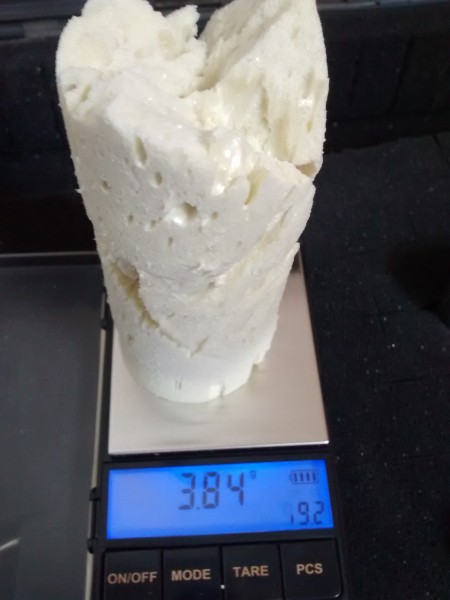
Image Credit: BlueGreen Consulting Group
When spray foam goes bad, it’s hard not to feel a bit sick. Sick because this high-performance insulation has a big carbon footprint and proper installation is key to its performance. When it’s not installed correctly, it can get expensive for the client, the contractor, and the planet.
If you look at spray foam as just a commodity, you’re sadly mistaken. The rigid foam that you buy at the big box store is produced in a highly controlled factory setting to exacting, repeatable standards and is tested for quality before it leaves the factory. Spray foam, on the other hand, is manufactured on the job site, so we’re banking on the person pulling the application gun’s trigger to know some foam chemistry and building science. That’s a rare combination, made rarer still if we expect that person to lay a lot of foam down quickly, cleanly, and uniformly.
The first rule with spray foam is “hire the installer spraying the foam, not the foam manufacturer or the foam brand.” By this I mean, the installer’s brain is the most valuable asset in selecting who will do the job. All else is secondary.
I was reminded of this a few weeks back when I visited a job site with terribly applied spray foam. It had every problem you could imagine: fire hazards created by the spray foam, charred foam, air leakage through the newly installed spray foam and missing foam. All in a day’s work!
Laying it on too thick
To install spray foam too thick is to ruin it. As a rule of thumb, most 2-pound spray foam or medium-density spray foam should be installed in layers no more than 2 inches thick. Each “pass” or “lift” should be allowed to cool before another layer is added.
This foam was sprayed in too thick a layer.
When the two liquid components of spray foam come together, there is a very rapid exothermic (heat-producing) chemical reaction. Good foam has to be cooled quickly or it cracks and chars. If it’s too thick, the insulating properties of the spray foam trap the heat. In the video above, I’m talking with Mike Cerqua of CallRich Eco Services, our go-to expert spray foamer who was called in to clean up this job. As we discover, defects in the foam become obvious without digging very far.

In this core, the color changes from a greenish hue at the base to a more yellow, toffee color at the top. The foam is inconsistent, and it had a very strong odor even after curing for two weeks.
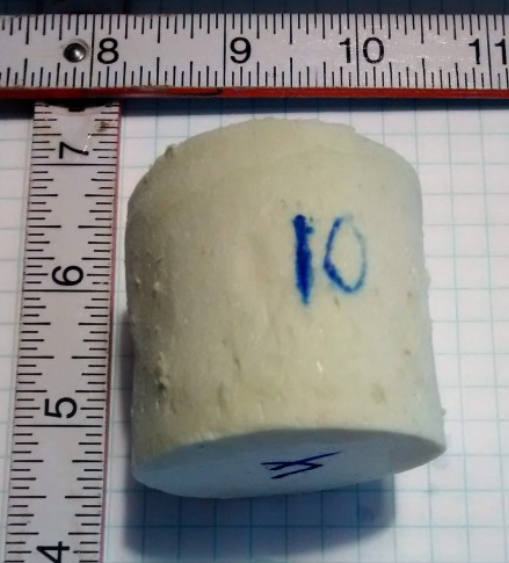
This spray foam core sample had a uniform cell structure (small bubbles) and was consistent in color throughout.
Preparing the substrate is equally important. We want the foam to be applied in even coat(s) on a solid, clean and uniform substrate the foam can stick to. Experienced sprayers who know the behavior of the product can repeatedly get the foam to cure in a nice even coat.
Note to self: With each layer of foam applied, defects get amplified, resulting in a bumpier finish.
Blisters or voids are caused by a number of things — including electrical wires, plumbing pipes, framing that creates shadows in the foam, poor access in a tight space, or just spraying over a messy area.
A good sprayer also will appreciate the fact that spray foam won’t stick to 6-mil polyethylene. So don’t expect a durable air seal if you are using polyethylene as your air barrier system.


Get an electrician to tame the wires by attaching them to the wood framing. Wires, pipes and framing will cause “shadows” in the foam as it’s projected out the gun, much like a flashlight will cause shadows in the dark. These shadows cause defects in the foam.
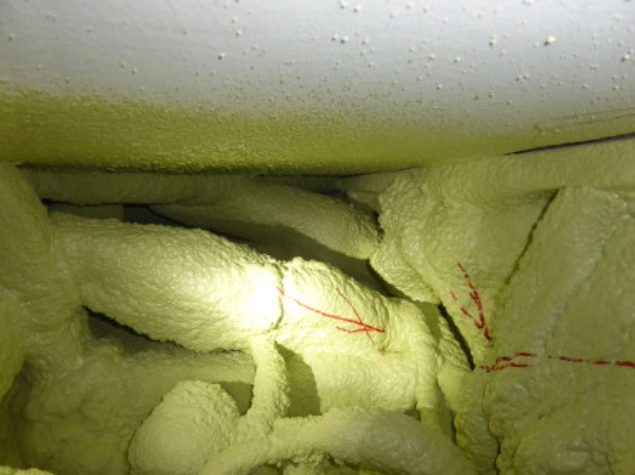
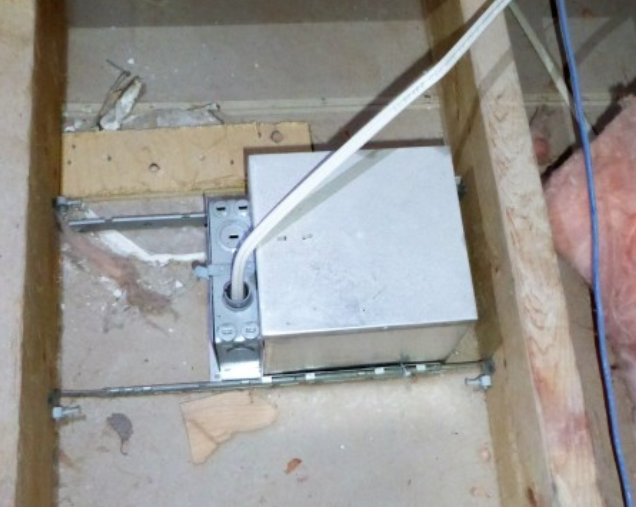
The difference between the two is that one may be spray-foamed directly, while spraying the other one may cause the pot light to overheat and should be considered a very serious fire hazard. Either way, if the pot light is installed through your air barrier, it’s going to leak air.
The moral of this tale: if you invest in spray foam, hire a good installer, And if the foam is part of the air barrier system, test it for air leakage.
_________________________________________________________________________
Greg Labbé is an energy and building consultant in Toronto. This blog originally appeared at the website of his company BlueGreen Consulting Group.
Weekly Newsletter
Get building science and energy efficiency advice, plus special offers, in your inbox.





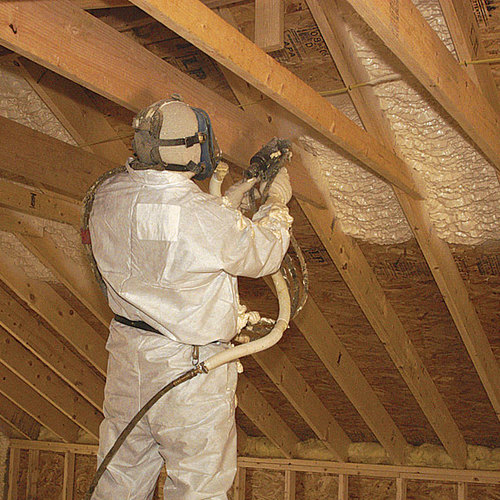

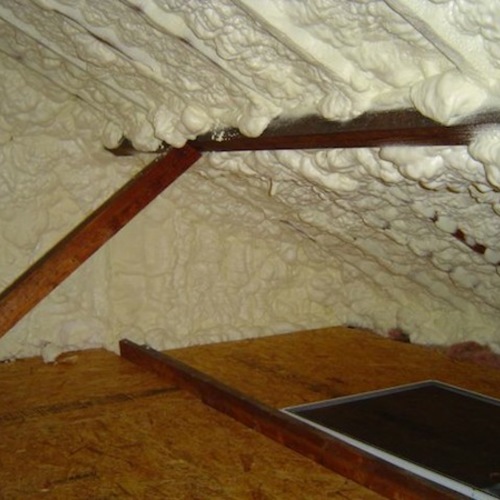







17 Comments
Recessed Can Lights and Spray Foam
Greg,
Great article; however, I'd like to offer a word of caution about directly encapsulating recessed can lights without providing necessary clearances. Currently, most IC fixtures are technically not rated for direct contact with spray foam. Below is the language listed on many recessed can light spec sheets:
"Fixture is not for use in recessed housings in direct contact with spray foam insulation per NEMA LSD 57-2013"
To be clear, the NEMA and SPFA study did NOT find a combustion hazard from encapsulating IC rated cans.
More from NEMA LSD 57-2013:
"Because polyurethane foam has a higher insulation value than the insulation types used for IC testing and rating, foam insulation contact with recessed luminaires can elevate the fixture temperature above expected levels. This may cause accelerated degradation of the foam. IC rated fixtures are also equipped with a thermal protection device that turns off the lamp if the housing temperature exceeds prescribed limits.
Expanding foam can also cause a second unacceptable condition with recessed lighting fixtures and their associated junction boxes. As the foam expands, it can intrude into the crevices and small openings inherent with this type of equipment. After the foam hardens in these internal spaces, it can degrade the functionality of the luminaire, prevent routine maintenance as well as prevent inspection of and access to critical electrical connections.
Acceptable installation techniques applicable to Type-IC luminaires include, but are not limited to: a) masking the luminaire by wrapping it in fiberglass batting, or b) building a suitable barrier around the luminaire and/or junction box, c) installing a suitable luminaire and vapor barrier combination. Because polyurethane foam can exert significant force as it expands, any blocking mechanism must be sturdy enough to resist the resulting forces. The luminaire manufacturer must be contacted for specific installation guidelines applicable to their products."
More here:
Spray Foam and Recessed Light Fixtures - Recent Test Results from a NEMA/SPFA Study
NEMA LSD 57-2013 Polyurethane Foam Application: Lighting Equipment
Foam in the basement?
"A good sprayer also will appreciate the fact that spray foam won’t stick to 6-mil polyethylene. So don’t expect a durable air seal if you are using polyethylene as your air barrier system."
Then why do the first two insulation quotes I've received specify closed cell foam down the walls to seal with the poly vapor barrier? How should the foamed walls tie in with the vapor barrier on the floor?
recycling
Good article Greg. It further confirms my decision to never recommend spray foam, it really seems to be too difficult to get a satisfactory result. But my main concern is that foam renders all the materials it touches unrecyclable and that alone should make this product unacceptable and banned from the construction industry. And its carbon footprint should be the final nail in the coffin. What do you think? Am I being unreasonable?
Response to Kim Dolce
Kim,
In a conventional basement, the concrete slab is an air barrier. The concrete wall is also an air barrier. To make sure that the air barrier is continuous, the usual advice is to caulk the crack between the slab and the wall.
If you do that, you won't be depending on spray foam to complete your air barrier. To the extent that spray foam may overlap the crack between the slab and the wall, it will certainly reduce air leakage at that crack, which is a good thing.
If you have polyethylene under your concrete slab, it's an effective vapor barrier. There is no building science justification for worrying about tying that sub-slab vapor barrier to a wall vapor barrier.
To limit the flow of water vapor through your basement walls, either rigid foam or closed-cell spray foam is effective. Since closed-cell spray foam is already a vapor barrier, there is no need to install polyethylene on a wall insulated with closed-cell spray foam -- and in fact installing polyethylene on such a wall is not recommended.
I don't recommend the use of open-cell spray foam to insulate a basement wall.
For more information on this topic, see How to Insulate a Basement Wall.
Skylar Swinford
Skylar,
Thanks for the reference, I totally agree about foam being pushed in through the stamped, metal box and I also feel uneasy about the foam directly against even IC rated boxes. The best really is to simply avoid pot lights in the top floor ceiling or if they can't be avoided, drop the ceiling away/under the air and vapour retarder to create a mechanical electrical chase along the ceiling plane.
Kim Dolce
Kim,
I suspect if the poly is clamped and air sealed to a framing member and that enough of that framing member is exposed to the new spray foam for good adhesion you might be able to get a satisfactory seal. You could also try a "transition strip" by testing foam's adhesion to different approved air barrier tapes?
It should be noted the above was all part of a renovation to eliminate ice dams and it should be noted that retrofitting spray foam is a more complex job than new construction.
Marc Bombois
I shoudl have started off the article by saying all insulation types can be badly installed.When done properly though, spray foam is a wonderful insulation with the caveat that it has a lot of embodied energy. I struggle with this last point, especially for vintage masonry buildings where spray foam seems to work fairly well.
to Greg Labbe
And the caveat that at the end of the building's life that spray foam will probably be a liability. I imagine society will be apalled at the sight of the building being trashed because we can't recycle the components of the exterior walls. This lack of foresight seems a bit nuts to me. The regulators are dropping the ball on this one.
Response to Marc Bombois
Marc,
You are predicting a radical moral change. Buildings are routinely demolished in the U.S., and an insignificant percentage of these demolished buildings are processed for recycling. In spite of this "appalling" fact, I note a decided lack of protestors or weeping onlookers.
But perhaps in 50 years, things will be different.
Marc
Over the last year I watched a large local high school being demolished, the components sorted and recycled right down to the door and window hardware being stored for replacement parts for other buildings and crushing the concrete foundation for aggregate. Among the more valuable salvage were a large quantity of beautiful old growth D. fir beams. No spray foam for me.
Response to Malcolm Taylor
Malcolm,
That sounds like an unusually conscientious demolition contractor. In my neck of the woods, I've never seen a demolition contractor take that approach. I'm glad to hear that it's happening more these days.
Martin
it was a public building which helped, but the main reason for the careful separation was that most construction materials are no longer accepted at our regional dump. In turn a market has developed for the salvage. Watching the school be sorted and disappear from its very prominent site on a main road was an eye-opener for many of us.
to Martin
Martin, I tend to forget that everyone isn't familiar with the details of my renovation. Our basement has a dirt floor and the quotes have called for everything from 6mil poly to EPDM to pouring a slab, all with foam on the walls that would "seal" the specified membrane. We're leaning towards the slab though we have little interest in using spray foam anywhere in the building other than in small amounts to seal cracks, etc. our reasons being a combo of health and environmental concerns along with a bit of reverence for the old building we're renovating.
Response to Kim Dolce
Kim,
Fixing a dirt-floored basement is similar to fixing a dirt-floored crawl space. For more information on the topic, see Building an Unvented Crawl Space.
Salvage
Martin and Malcolm, salvage is pretty normal here in BC. For example, the high-end builder where I am buys up every stick of salvaged lumber and timber he can get, has it remilled and uses it for finishing. It's quite stunning the character this wood has. As well, there's an outfit called Demex that stocks used construction components, especially windows and doors. Anywho, I sure hope you're wrong Martin about it taking fifty years to see a change in attitudes around this.
Response to Marc Bombois
Marc,
As I told Malcolm, I'm glad to hear that there are regions of North America where salvage is routine. That's good news.
I'm no stranger to salvage. My house includes beams and hardwood flooring that I salvaged in the 1970s from homes slated for demolition.
The main barrier to salvage is that (in many cases) the labor cost to remove fasteners is higher than the value of the salvaged material. When it comes to re-milling old lumber, most millwork shops would rather see a little bit of adhered spray foam than a nail or screw. Removing every last fastener isn't a simple task, especially when the nails were driven by a nail gun.
The value
Martin, is the labour cost to remove fasteners higher than the value of the salvaged material, or are the environmental and labour and embodied energy costs of new materials higher than that? I don't know, but looking around at the status quo makes me wonder. And "a little bit of adhered spray foam"? What millwork shop is going to remill lumber that has foam on it that may be hiding metal fasteners? What are they going to do with the shavings that contain spray foam? Sell it as garden mulch? No thanks. I can't help but think this stuff is a disaster in waiting. I agree that energy conservation is crucial in building but we can do better than this.
Log in or create an account to post a comment.
Sign up Log in